Marigolds
Marigolds are a summer garden mainstay. They are the  happy orange and yellow flowers that just won’t quit! Marigolds are easy to grow and provide continuous blooms throughout the warm months. They’re edible, too!
happy orange and yellow flowers that just won’t quit! Marigolds are easy to grow and provide continuous blooms throughout the warm months. They’re edible, too!
About Marigolds
Marigolds are native to Central and South America. European explorers brought the plant back home and marigolds quickly spread across the continent and even into Africa and Asia. Thus two species are called "African Marigolds" and "French Marigolds" due to their development, not their origins. (African marigolds are taller plants with larger blooms while French are smaller plants with more compact flowers.)
Marigolds are typically orange, though yellow is also common. Other colors include red, maroon, and ivory. The common plants available at your local plant nursery reach a height of 12 inches, while African marigolds can grow as tall as 3 feet.
While marigolds are lovely to look at and beneficial in the garden, they have herbal benefits as well. Make marigold tea, stir in a little honey, and drink up for  healthy skin and good circulation. Sprinkle marigold flowers on a salad for extra color and subtle flavor.
healthy skin and good circulation. Sprinkle marigold flowers on a salad for extra color and subtle flavor.
For marigold inspiration, watch "Monsoon Wedding", an Indian film directed by Mira Nair. Marigold flowers are strung together for garlands, flower petals are scattered as decoration, and the wedding organizer eats blooms as he works.
How to Grow Marigolds
To start marigolds from seed, begin the growing process in late March/early April. The plants need about 45 days to flower after seeding. Cover seeds with 1/4 inch of potting soil. Maintain warm and moist soil. Plants will appear within  a few days. When true leaves have formed, transplant into individual containers and thin as necessary. Follow regular guidelines for maintaining plants as they grow.
a few days. When true leaves have formed, transplant into individual containers and thin as necessary. Follow regular guidelines for maintaining plants as they grow.
When your plants are ready (or when you’ve purchased ready-to-go plants), select a site that receives full sun. Marigolds grow best in well-drained soil. Water plants during dry weather. Fertilize sparingly since too much will result in lots of leaves and few blooms. Pinch off spent blooms to direct the plant’s energy to creating new flowers. At the end of the growing season, allow a few blooms to dry on the plant to harvest seeds for the following year.





